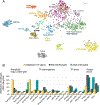How advanced are we in targeting novel subtypes of ALL?
- PMID: 31779973
- PMCID: PMC6927537
- DOI: 10.1016/j.beha.2019.101095
How advanced are we in targeting novel subtypes of ALL?
Abstract
Despite high cure rates in children, acute lymphoblastic leukemia (ALL) remains a leading cause of cancer death in the young, and the likelihood of treatment failure increases with age. With the exception of tyrosine kinase inhibitors, there have been few advances in repurposing or developing new therapeutic approaches tailored to vulnerabilities of ALL subtypes or individual cases. Large-scale genome profiling studies conducted over the last decade promise to improve ALL outcomes by refining risk stratification and modulation of therapeutic intensity, and by identifying new targets and pathways for immunotherapy. Many of these approaches have been validated in preclinical models and now merit testing in clinical trials. This review discusses the advances in our understanding of the genomic taxonomy and ontogeny of B-progenitor ALL, with an emphasis on those discoveries of clinical importance.
Keywords: ALL; ALL subtype; Acute lymphoblastic leukemia; B-ALL; B-progenitor ALL; DUX4; ETV6-RUNX1; Genome profiling; Hypodiploid; IGH; IKZF1; MEF2D; NUTM1; PAX5; Ph-like; Taxonomy; ZNF384.
Copyright © 2019 Elsevier Ltd. All rights reserved.
Figures


References
-
- Hunger SP, Mullighan CG. Acute Lymphoblastic Leukemia in Children. N Engl J Med 2015;373:1541–1552. - PubMed
-
- Frey NV, Luger SM. How I treat adults with relapsed or refractory Philadelphia chromosome-negative acute lymphoblastic leukemia. Blood 2015;126:589–596. - PubMed
-
- Harrison CJ, Moorman AV, Schwab C, Iacobucci I, Mullighan C. Cytogenetics and Molecular Genetics In: Vora A, editor. Childhood Acute Lymphoblastic Leukemia. Cham: Springer International Publishing; 2017. p. 61–98.
Publication types
MeSH terms
Grants and funding
LinkOut - more resources
Full Text Sources

